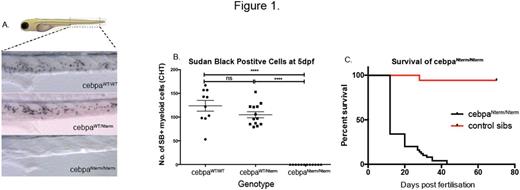Abstract
The current model for the pathogenesis of AML involves a normal haematopoietic stem or progenitor cell (HSPC) acquiring successive genetic abnormalities leading to clonal expansion and malignant transformation. Next generation sequencing (NGS) has facilitated the identification of more than 250 recurrent genetic changes in AML, with each case possessing between 5-20. Only a fraction of these have been validated as driver events, and the epistatic relationships and cellular consequences of combined mutational genotypes remain largely unexplored. A unique insight into this is afforded by a subset of patients who have inherited a mutation that predisposes to the development of AML, so-called familial leukaemia with predisposition to AML (FPD-AML) since these mutations are unequivocally the initiating driver mutations. One such mutation occurs in the N-terminal domain of the transcription factor CEBPA. To further understand the role of N-terminal CEBPA mutations and co-operating secondary driver mutations we have used a TALEN pair to generate a zebrafish model carrying an analogous N-terminal frame-shift mutation in Cebpa (cebpaNterm).
Initial analysis shows cebpaNterm/Nterm mutants have severe defects in developmental myelopoeisis. By 5 days post fertilisation (dpf), homozygous cebpaNterm/Nterm mutants show a complete absence of Sudan Black (SB) staining myeloid cells. cebpaNterm/+siblings display a minor delay in myeloid development, but no significant difference in numbers of SB staining cells at 5 dpf (Figure 1A,B). cebpaNterm/Nterm mutants are morphologically indistinguishable from their siblings during the first 5 days of life, however, they show diminished growth and survival thereafter. At 4 weeks, remaining juvenile cebpaNterm/Nterm mutants show markedly reduced length and weight compared to age matched controls (cebpa+/+and cebpaNterm/+) and are not viable beyond 8 weeks (Figure 1C).
To facilitate assessment of HSPCs/thrombocytes and myeloid cells, we crossed cebpaNterm/+mutants to transgenic reporter lines expressing eGFP from the CD41 promoter (Tg(cd41:eGFP)) and mCherry (mCh) from the lysozyme C promoter (Tg(LyzC:mCherry)). Tg(LyzC:mCherry);cebpaNterm/Nterm fry can be distinguished from their siblings in vivo by the absence of mCherry expressing myeloid cells from 3.5dpf. Flow cytometric analysis in surviving juveniles at 32dpf demonstrated a continued absence of mCh expressing myeloid cells in both peripheral blood and whole kidney marrow. However, evaluation of cebpaNterm/Nterm mutant juveniles at 6 weeks showed evidence of increased numbers of mCh positive cells, compared to wild type and heterozygous sibling controls. Blood smears in homozygous mutants at this stage also revealed cells morphologically suggestive of primitive myeloid origin. Finally, epifluorescent microscopy of 4-6 week old fish demonstrated a widespread GFP dim fluorescence in the cebpaNterm/Nterm mutants. In contrast siblings displayed only GFP bright thrombocytes, suggesting an expansion of CD41-GFPdimexpressing HSPC-like cells in mutant animals.
The occurrence of biallelic N-terminal CEBPA-mutations in human AML is however extremely rare. By contrast the most frequent "second hit" mutation occurs in the C-terminal DNA binding domain of the other allele of CEBPA. These mutations are universally in frame deletions or insertions, suggesting retained dimerization capability but abrogation of DNA binding. We have generated a knock-in C-terminal model of the most commonly observed human mutation in the orthologous zebrafish sequence using TALENs and plasmid mediated homology directed repair. This donor plasmid adds 3bp encoding an additional leucine within the C-terminal zipper domain. MISEQ analysis of F0 putative founder eggs and sperm has shown a 2-5% germline transmission rate of the knockin allele. In addition to CEBPA C-terminal mutations, a number of other recurrently mutated genes have been found in CEBPA mutated AML. Our ongoing work will assess the effects of combined N and C terminal cebpa mutation, along with CRISPR-targeting of other common "second hits" including cohesion proteins, WT1, GATA2 and TET2 to define their role in leukaemogenesis in CEBPA-mutated AML. Our ongoing experiments are also defining the self-renewal capacity of myeloid and HSPCs derived from 4-6 week old cebpaNterm/Nterm mutants using rag2E450fsknockout transplantation assays.
No relevant conflicts of interest to declare.
Author notes
Asterisk with author names denotes non-ASH members.


This feature is available to Subscribers Only
Sign In or Create an Account Close Modal